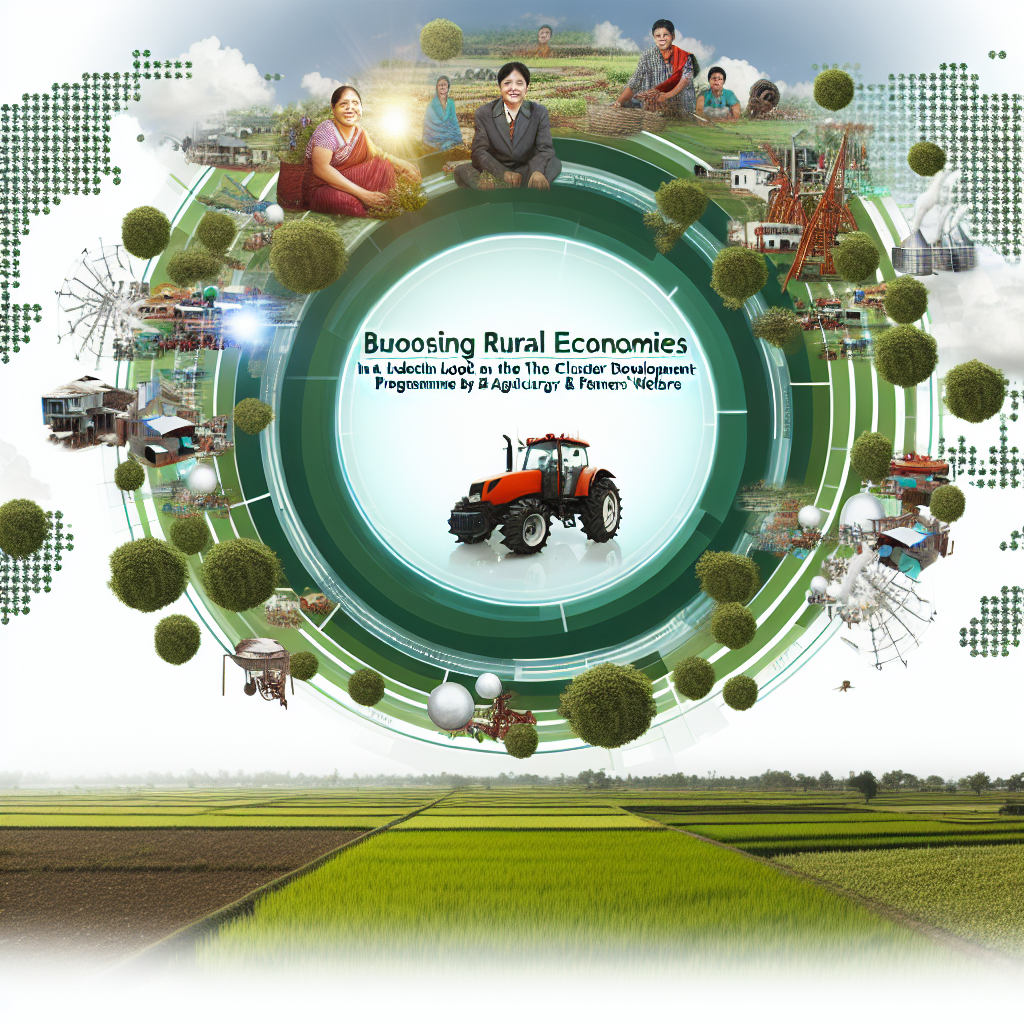Copyright @ 2023 www.digimitr.com. All rights reserved.

Boosting Rural Economies: An In-Depth Look at the Cluster Development Programme by the Ministry of Agriculture & Farmers Welfare
Discover the key aspects of the government scheme titled “Boosting Rural Economies: An In-Depth Look at the Cluster Development Programme by the Ministry of Agriculture & Farmers Welfare”. This program is overseen by the relevant ministry and aims on delivering benefits to eligible beneficiaries.
Here is a comprehensive overview:
The rural economy in India holds immense potential for growth and development. Recognizing this, the Ministry of Agriculture & Farmers Welfare has introduced various initiatives aimed at bolstering rural livelihoods and promoting sustainable practices. One of the most pivotal initiatives is the Cluster Development Programme (CDP). This program aims to create a conducive environment for rural entrepreneurship by organizing agricultural clusters, which are groups of farms in close proximity that focus on a specific crop or agricultural activity. By efficiently pooling resources, knowledge, and skills, the CDP seeks to enhance productivity and ultimately improve the quality of life for rural farmers.
Eligibility Criteria
To participate in the Cluster Development Programme, there are certain eligibility criteria that both individuals and groups must meet. Primarily, the program targets small and marginal farmers who collectively engage in the cultivation of specific crops or products. Applicants must be recognized legal entities, such as farmers’ cooperatives or self-help groups (SHGs).
Additionally, the clusters should ideally consist of a minimum number of farmers, often stipulated by the local agricultural authority. The farmers involved must exhibit a genuine willingness to collaborate and develop their farming practices along the lines set out by the program. Furthermore, regions with existing clusters or a demonstrated potential for clustering are given preference during the application process.
Key Features and Benefits
The Cluster Development Programme boasts several key features designed to boost rural economies. One of the hallmark aspects of the CDP is its focus on value addition. Instead of just selling raw agricultural products, the program encourages farmers to undertake processing activities, thereby enhancing the market value of their produce.
Another vital feature of the CDP is skill development. The program includes training sessions that equip farmers with modern agricultural techniques, crop management practices, and effective marketing strategies. This education raises the standard of agricultural practices and promotes the establishment of agripreneurship within rural communities.
Moreover, the program also fosters community participation, encouraging collaboration among stakeholders. This can lead to the establishment of cooperatives, enabling farmers to negotiate better prices collectively, thus enhancing their bargaining power in the market. The support of financial institutions and government agencies further solidifies the robustness of this initiative.
Application Process
The application process for the Cluster Development Programme is fairly streamlined to facilitate easy participation. Interested farmers or groups are required to submit an application to the Ministry of Agriculture through the designated state agriculture department. The application must include details regarding the farmers’ group, the type of cluster proposed, and a preliminary business plan outlining the objectives and benefits of the cluster.
Once the proposal is submitted, it undergoes a thorough screening process in which the state agricultural authorities review the potential impact and viability of the proposed cluster. If approved, the applicants are invited for a public consultation where community input is gathered. This collaborative approach ensures the initiative is tailored to the specific needs of the locality.
Funding and Budget
Funding for the Cluster Development Programme comes from the Central government, supplemented by contributions from state governments and private stakeholders. The financial resources allocated are primarily aimed at infrastructural development, skill training, and marketing support.
The budget is determined based on the specific needs of the clusters and can vary significantly depending on the scale of the initiative. Typically, the funding covers expenditures related to the establishment of processing units, cold storage, and other necessary facilities. The financial framework is designed to ensure sustainability in rural entrepreneurship, thereby decreasing reliance on external aid over time.
Achievements or Impact
Since its inception, the Cluster Development Programme has shown a promising impact on rural economies. Various clusters have reported improved income levels, with farmers experiencing up to a 30% increase in their earnings post-implementation.
Empowerment of women through self-help groups has also been a noteworthy achievement. Women not only participate in farming activities but are also at the forefront of processing and marketing, resulting in positive socio-economic changes within households.
The program has also facilitated the establishment of agricultural cooperatives, which improve the supply chain and allow farmers access to better markets, credit facilities, and technology. The positive ripple effects are reflected in improved food security and nutritional standards in rural areas.
Challenges
Despite its successes, the Cluster Development Programme has encountered certain challenges. One of the primary issues is the resistance to change among traditional farmers, who may be hesitant to adopt new practices. Additionally, there are instances of inadequate infrastructure and poor accessibility to markets, which can hinder the program’s effectiveness.
Furthermore, the complexity involved in aligning various stakeholders to work cohesively within a cluster can sometimes create coordination challenges. Ensuring consistent financial support and continuous training to keep pace with agricultural advancements remains essential for sustained impact.
Recent Updates
In recent months, the Ministry of Agriculture has emphasized scaling up the Cluster Development Programme. Initiatives such as digitization have been proposed to streamline the monitoring process and engage younger farmers through technology-based platforms.
Strengthened relationships with financial institutions and private-sector players have also been established to enhance investment in rural clusters. Special focus has been directed towards establishing clusters for high-demand crops and value-added products, which aligns with emerging market trends.
Conclusion
The Cluster Development Programme by the Ministry of Agriculture & Farmers Welfare represents a significant step towards transforming rural economies in India. By focusing on collective farming efforts, enhancing skills, and facilitating value-addition processes, the program enables farmers to compete effectively in larger markets. While challenges remain, ongoing adaptations and recent updates signal continued commitment to improving rural livelihoods.
FAQ
1. What types of crops or products can be included in the Cluster Development Programme?
The program is flexible and can include a variety of agricultural products, including fruits, vegetables, grains, and dairy products. It primarily targets crops that have high market demand and the potential for value addition.
2. How long does it typically take for a cluster to become operational after application?
The timeframe for a cluster to become fully operational can vary widely, but generally, it may take several months to over a year, depending on the state of implementation, resource availability, and the complexity of the proposed activities.
3. Are there any specific training programs associated with the Cluster Development Programme?
Yes, the program includes tailored training modules designed to equip farmers with modern agricultural techniques, marketing strategies, and management practices, ensuring they can maximize their productivity and profitability.
For more information, check out official government site,
Official government website or relevant source not provided.
Stay updated on related schemes and initiatives using hashtags: #Boosting #Rural #Economies #InDepth #Cluster #Development #Programme #Ministry #Agriculture #Farmers #Welfare
Share your thoughts about this scheme in the comments below!





